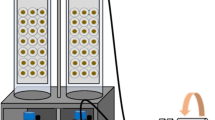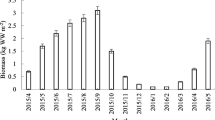Abstract
Controlled cultivation of marine macroalgal biomass such as Ulva species, notably Ulva lactuca, is currently studied for production of biofuels or functional food ingredients. In a eutrophic environment, this macrophyte is exposed to varying types of nutrient supply, including different and fluctuating levels of nitrogen sources. Our understanding of the influences of this varying condition on the uptake and growth responses of U. lactuca is limited. In this present work, we examined the growth response of U. lactuca exposed to different sources of nitrogen (NH +4 ; NO −3 ; and the combination NH4NO3) by using photo-scanning technology for monitoring the growth kinetics of U. lactuca. The images revealed differential increases of the surface area of U. lactuca disks with time in response to different N-nutrient enrichments. The results showed a favorable growth response to ammonium as the nitrogen source. The NH4Cl and NaNO3 rich media (50 μM of N) accelerated U. lactuca growth to a maximum specific growth rate of 16.4 ± 0.18% day−1 and 9.4 ± 0.72% day−1, respectively. The highest biomass production rate obtained was 22.5 ± 0.24 mg DW m−2·day−1. The presence of ammonium apparently discriminated the nitrate uptake by U. lactuca when exposed to NH4NO3. Apart from showing the significant differential growth response of U. lactuca to different nitrogen sources, the work exhibits the applicability of a photo-scanning approach for acquiring precise quantitative growth data for U. lactuca as exemplified by assessment of the growth response to two different N-sources.




Similar content being viewed by others
References
Abd El-Baky HH, El Baz FK, El-Baroty GS (2008) Evaluation of marine alga Ulva lactuca L. as a source of natural preservative ingredient. EJEAFChe 7:3353–3367
Bixler HJ (1996) Recent developments in manufacturing and marketing carrageenan. Hydrobiologia 326(327):35–57
Bodin-Dubigeon C, Lahaye M, Barry JL (1997) Human colonic bacterial degradability of dietary fibres from sea-lettuce (Ulva sp.). J Sci Food Agric 73:149–159
Campbell WH, Kinnunen-Skidmore T, Brodeur-Campbell MJ, Campbell ER (2004) New and improved nitrate reductase for enzymatic nitrate analysis. Am Lab 22:12
Christensen HF, Sand-Jensen K (1990) Growth rate and carbon affinity of Ulva lactuca under controlled levels of carbon, pH and oxygen. Mar Biol 104:497–501
Cumashi A, Ushakova NA, Preobrazhenskaya ME, D’Incecco A, Piccoli A, Totani L, Tinari N, Morozevich GE, Berman AE, Bilan MI, Usov AI, Ustyuzhanina NE, Grachev AA, Sanderson CJ, Kelly M, Rabinovich GA, Iacobelli S, Nifantiev NE (2007) A comparative study of the anti-inflammatory, anticoagulant, antiangiogenic, and antiadhesive activities of nine different fucoidans from brown seaweeds. Glycobiology 17:541–552
Copertino MS, Tormena T, Seeliger U (2008) Biofiltering efficiency, uptake and assimilation rates of Ulva clathrata (Roth) J. Agardh (Clorophyceae) cultivated in shrimp aquaculture waste water. J Appl Phycol 21:31–45
DeBoer JA, Guigly HJ, Isarael TL, D’Elia CF (1978) Nutritional studies of two red algae. I. Growth rate as a function of nitrogen source and concentration. J Phycol 14:261–266
De Roeck-Holtzhauer Y (1991) Uses of seaweed in cosmetics. In: Guiry MD, Blunden G (eds) Seaweed resources in Europe: uses and potential. Wiley, Chichester, pp 83–94
Doran PM (1995) Homogeneous reactions. Bioprocess engineering principles. Academic, San Diego, pp 277–278
Doty MS (1971) Measurement of water movement in reference to benthic algal growth. Bot Mar 14:32–35
Hiraoka M, Oka N (2008) Tank cultivation of Ulva prolifera in deep seawater using a new germling cluster method. J Appl Phycol 20:97–102
Ivanova I, Rouseva R, Kolarova M, Serkedjieva J, Rachev R, Manolova N (1994) Isolation of a polysaccharide with antiviral effect from Ulva lactuca. Prep Biochem 24:83–97
Knauf M, Moniruzzaman M (2004) Lignocellulosic biomass processing: a perspective. Int Sugar J 106:147–150
Koroleff F (1970) Direct determination of ammonia in natural waters as indophenol blue. In Information on techniques and methods for seawater analysis. Interlaboratory report No. 3. I.C.E.S. Charlottenlund, pp 19–22
Lahaye M (1991) Marine algae as sources of fibres: determination of soluble and insoluble dietary fibre contents in some sea vegetables. J Sci Food Agric 54:587–594
Lahaye M, Axelos MAV (1993) Gelling properties of water-soluble polysaccharides from proliferating marine green seaweeds (Ulva spp.) Carbohydrate. Polymer 22:261–265
Lara C, Romero JM, Guerrero MG (1987) Regulated nitrate transport in the cyanobacterium Anacystis nidulans. J Bacteriol 169:4376–4378
Lee T-M (2000) Phosphate starvation induction of acid phosphatase in Ulva lactuca L. (Ulvales, Chlorophyta). Bot Bull Acad Sin 41:19–25
Magnusson G, Larsson C, Axelsson L (1996) Effects of high CO2 treatment on nitrate and ammonium uptake by Ulva lactuca grown in different nutrient regimes. Sci Mar 60:179–189
Msuya FE, Neori A (2008) Effect of water aeration and nutrient load level on biomass yield, N uptake and protein content of the seaweed Ulva lactuca cultured in seawater tanks. J Appl Phycol 20:1021–1031
Naldi M, Wheeler PA (2002) 15N Measurement of ammonium and nitrate uptake by Ulva fenestrata (Chlorophyta) and Gracilaria pacifica (Rhodophyta): comparison of net nutrient disappearance, release of ammonium and nitrate and 15N accumulation in algal tissue. J Phycol 38:135–144
Neori A, Cohen I, Gordin H (1991) Ulva lactuca biofilters for marine fishfond effluents II. Growth rate, yield and C:N ratio. Bot Mar 34:483–489
Ortiz J, Romero N, Robert P, Araya J, Lopez-Hernandez J, Bozzo C, Navarrete E, Osorio A, Rios A (2006) Dietary fiber, amino acid, fatty acid and tocopherol contents of the edible seaweeds Ulva lactuca and Durvillaea antarctica. Food Chem 99:98–104
Parker HS (1981) Influence of relative water motion on the growth, ammonium uptake and carbon and nitrogen composition of Ulva lactuca (Chlorophyta). Mar Biol 63:309–318
Pedersen FP (1994) Transient ammonium uptake in the macroalga Ulva lactuca (Chlorophyta): nature, regulation, and the consequences for choice of measuring technique. J Phycol 30:980–986
Sand-Jensen K (1988) Minimum light requirements for growth in Ulva lactuca. Mar Ecol Prog Ser 50:187–193
Sato K, Eksangsri T, Egashira R (2006a) Ammonia-nitrogen uptake by seaweed for water quality control in intensive mariculture ponds. J Chem Eng Japan 39:247–255
Sato K, Ueno Y, Egashira R (2006b) Uptake of nitrate-nitrogen in intensive shrimp culture ponds by sterile Ulva sp. J Chem Eng Japan 39:1128–1131
Thomas TE, Harrison PJ (1987) Rapid ammonium uptake and nitrogen interactions in five intertidal seaweeds grown under field condition. J Exp Mar Biol 107:1–8
Vandermeulen H, Gordin H (1990) Ammonium uptake using Ulva (Chlorophyta) in intensive fishpond systems: mass culture and treatment of effluent. J Appl Phycol 2:363–374
Vermaat JE, Sand-Jensen K (1987) Survival, metabolism and growth of Ulva lactuca under winter conditions: a laboratory study of bottlenecks in the life cycle. Mar Biol 95:55–61
Acknowledgment
The authors are grateful to Michael Bo Rasmussen of the National Environmental Research Institute (DMI), University of Aarhus—Silkeborg, Denmark for providing the U. lactuca strain.
Author information
Authors and Affiliations
Corresponding author
Rights and permissions
About this article
Cite this article
Ale, M.T., Mikkelsen, J.D. & Meyer, A.S. Differential growth response of Ulva lactuca to ammonium and nitrate assimilation. J Appl Phycol 23, 345–351 (2011). https://doi.org/10.1007/s10811-010-9546-2
Received:
Revised:
Accepted:
Published:
Issue Date:
DOI: https://doi.org/10.1007/s10811-010-9546-2




